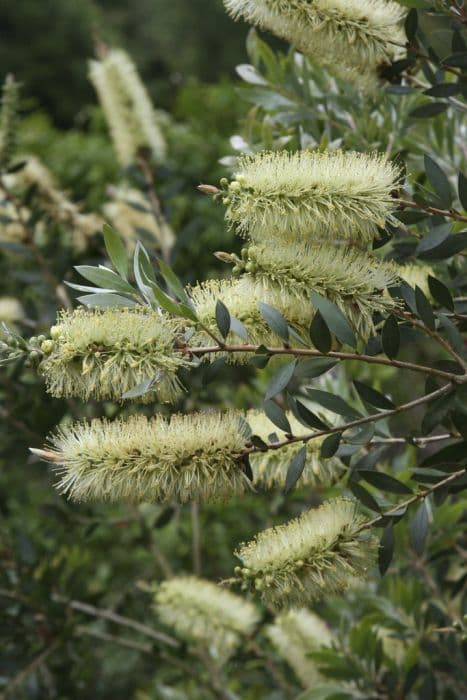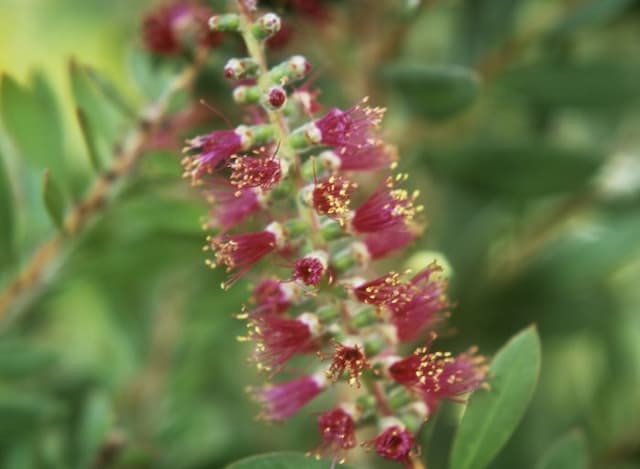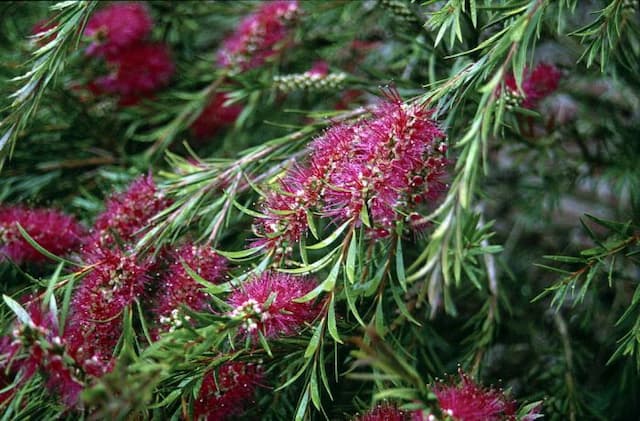Tasmanian blue gum Eucalyptus globulus

ABOUT
E. globulus is a fast-growing evergreen tree to 30m or more, with white to cream, yellow or grey bark that sheds in ribbons to reveal light green and brown inner bark. It has highly aromatic foliage, the juvenile leaves ovate and blue-white; adult leaves sickle-shaped. White flowers are borne on mature trees in spring or summer
About this plant
 Names
NamesSynonyms
Blue Gum, Tasmanian Blue Gum, Southern Blue Gum, Blue Eucalyptus
Common names
Eucalyptus maidenii subsp. globulus, Eucalyptus gigantea, Eucalyptus pseudoglobulus.
 Characteristics
CharacteristicsLife cycle
Perennials
Foliage type
Evergreen
Color of leaves
Blue-green
Flower color
White
Height
180 feet (55 meters)
Spread
45 feet (14 meters)
Plant type
Tree
Hardiness zones
9
Native area
Australia
Benefits
 General Benefits
General Benefits- Eucalyptus oil production: The leaves of the Eucalyptus globulus, commonly known as blue gum, are a primary source of eucalyptus oil, which is used in a variety of products including decongestants, antiseptics, and insect repellents.
- Aromatherapy: The strong aroma of blue gum is often used in aromatherapy to help reduce stress and create a soothing environment.
- Windbreaks: Blue gum trees are commonly planted as windbreaks to protect against soil erosion and to shield smaller plants from strong winds.
- Habitat: These trees offer habitat to a number of wildlife species; their blossoms are a food source for bees and birds, while the tree itself can provide shelter.
- Ornamental use: Blue gum is sometimes grown as an ornamental tree in parks and large gardens for its attractive foliage and bark.
- Timber production: The wood of blue gum is used commercially for timber; it's known for its strength and durability, making it suitable for construction and furniture.
- Erosion control: The rapid growth and extensive root system of blue gum trees make them effective at stabilizing soil, helping to prevent erosion in vulnerable areas.
- Renewable energy: The biomass from blue gum can be used for producing renewable energy in the form of biofuel or wood pellets for heating.
- Honey production: Blue gum forests are a significant nectar source for honey production, with the resulting honey having a distinctive flavor.
- Shade provision: Their large canopy can provide ample shade, making them useful in controlling local microclimates and reducing sun exposure in hot regions.
 Medical Properties
Medical Properties- Expectorant – Eucalyptus globulus is used to thin respiratory secretions and to treat coughs.
- Antiseptic – The oil has properties that can help to reduce infection and kill bacteria.
- Anti-inflammatory – Eucalyptus leaves may help to reduce inflammation and treat conditions, such as rheumatoid arthritis.
- Analgesic – It may provide pain relief for minor wounds and muscle pain.
- Decongestant – Inhaled eucalyptus vapors are used to help relieve nasal congestion.
- Antispasmodic – It can help to relieve spasms in the respiratory system.
- Stimulant – The plant has been known to increase blood flow and has stimulant properties.
- Antimalarial – Eucalyptus oil contains compounds with potential antimalarial activity.
- Antioxidant – Compounds found in the plant could have potential antioxidant benefits.
 Air-purifying Qualities
Air-purifying QualitiesThis plant is not specifically known for air purifying qualities.
 Other Uses
Other Uses- Eucalyptus globulus, commonly known as Blue Gum, leaves are used as a natural dye for fabrics, providing a range of earthy tones.
- The wood chips of Blue Gum are an important material in paper production, offering a sustainable source of pulp.
- The essential oil derived from Blue Gum is used in aromatherapy diffusers to create a refreshing and invigorating environment.
- The fast-growing nature of Blue Gum makes it suitable for renewable timber production, aiding in sustainable forestry practices.
- Blue Gum can be used as a mulch for gardens, providing nutrients to the soil as it decomposes and deterring weeds.
- The thick bark of the Blue Gum tree is sometimes used in crafting and as a natural canvas for artisanal works.
- Eucalyptus globulus is often planted as a windbreak or for erosion control, thanks to its robust root system.
- Blue Gum leaves, when crushed, can be used as a natural insect repellent.
- The nectar from Blue Gum flowers is a valuable source for honey production, contributing to unique flavors in the honey.
- As a bioenergy source, Blue Gum is cultivated for use in biomass power plants due to its high calorific value when burned.
Interesting Facts
 Feng Shui
Feng ShuiThe Eucalyptus is not used in Feng Shui practice.
 Zodiac Sign Compitability
Zodiac Sign CompitabilityThe Eucalyptus is not used in astrology practice.
 Plant Symbolism
Plant Symbolism- Healing: The eucalyptus globulus, commonly known as the Blue Gum, is often associated with healing due to its medicinal properties, particularly its use in treating respiratory issues.
- Protection: Eucalyptus has been thought to ward off evil spirits and offer protection, a belief possibly stemming from its strong aroma which is also a natural insect repellent.
- Purification: The cleansing scent of the Blue Gum is symbolic of purification and the clearing of negative energy, making it popular in rituals of space cleansing.
- Renewal: The fast growth and resilience of the eucalyptus tree embody renewal and the ability to overcome obstacles.
 Water
WaterThe Blue Gum, commonly known as the Eucalyptus globulus, prefers evenly moist soil and does not tolerate being overly waterlogged. Water young trees with about 5 gallons per week during dry periods, but reduce the amount as they mature since established trees are quite drought tolerant. Newly planted trees require regular watering until they are well-established, generally for at least a couple of seasons. During the growing season, water thoroughly when the top inch of soil feels dry to the touch. In winter, reduce watering but do not let the soil dry out completely.
 Light
LightBlue Gum thrives best in full sun conditions, meaning it should receive direct sunlight for at least 6 hours a day. The best spot for the Eucalyptus globulus is an open area, away from buildings or shade-providing trees, as it needs ample light for healthy growth. Consider southern or western exposures for planting to ensure maximum sunlight exposure.
 Temperature
TemperatureBlue Gum's ideal temperature range is between 50° to 60°F at night and 60° to 70°F during the day. They can tolerate temperatures down to about 20°F but will suffer damage if exposed to extreme cold for prolonged periods. They should be grown in USDA hardiness zones 8 to 11 for optimal health and growth.
 Pruning
PruningPrune Blue Gum to shape the tree, encourage branching, or remove any damaged or diseased limbs. Pruning is best done in late winter or early spring before the new growth starts. Annually inspect the tree and remove only the necessary branches to maintain the tree's health and desired form.
 Cleaning
CleaningAs needed
 Soil
SoilBlue Gum prefers well-draining, loamy soil with a pH between 6.0 and 7.5. A standard potting mix amended with perlite and a slow-release fertilizer will provide an optimal growing medium.
 Repotting
RepottingYoung Blue Gum trees should be repotted every two years, but mature trees can be repotted less frequently, every three to five years or as needed when roots outgrow the current pot.
 Humidity & Misting
Humidity & MistingBlue Gum thrives in environments with moderate to low humidity; avoid overly humid conditions as they may encourage diseases.
 Suitable locations
Suitable locationsIndoor
Place in bright, indirect sun and ample space to grow.
Outdoor
Full sun, shelter from harsh winds, space to accommodate size.
Hardiness zone
9-11 USDA
 Life cycle
Life cycleThe life cycle of the Blue Gum (Eucalyptus globulus) begins with the germination of seeds, typically after a fire has cleared the land and triggered the release of seeds from the tree's capsules. The seedlings emerge and establish themselves, going through a rapid juvenile phase where they develop long, bluish-green leaves that hang downwards. As the tree matures, it enters the adult phase, characterized by shorter, more rounded and stiff leaves, and begins to develop flowers. These cream-colored flowers are pollinated primarily by bees, leading to the formation of woody fruit capsules, which contain numerous small seeds. Once mature, the capsules release seeds either spontaneously or through environmental triggers such as fire, thereby completing the reproductive cycle. Over the course of its life, which can span over 250 years, the Blue Gum may undergo this cycle several times, growing into tall, dominant trees in the forest canopy.
 Propogation
PropogationPropogation time
Spring-summer
Eucalyptus globulus, commonly known as the Tasmanian blue gum, is typically propagated from seed. The most favorable time for sowing seeds is during the warmer months, ideally in spring or early summer. To propagate by seeds, they are sown in a well-draining seed-raising mix. Surface sowing is the preferred method due to the small size of the seeds. Seeds should be lightly covered with a fine layer of soil or sand. The soil must be kept moist but not waterlogged, and in a warm sunny position. Germination usually occurs within 2 to 3 weeks, after which the seedlings can eventually be transplanted into individual pots when they are suitably large enough to handle.









